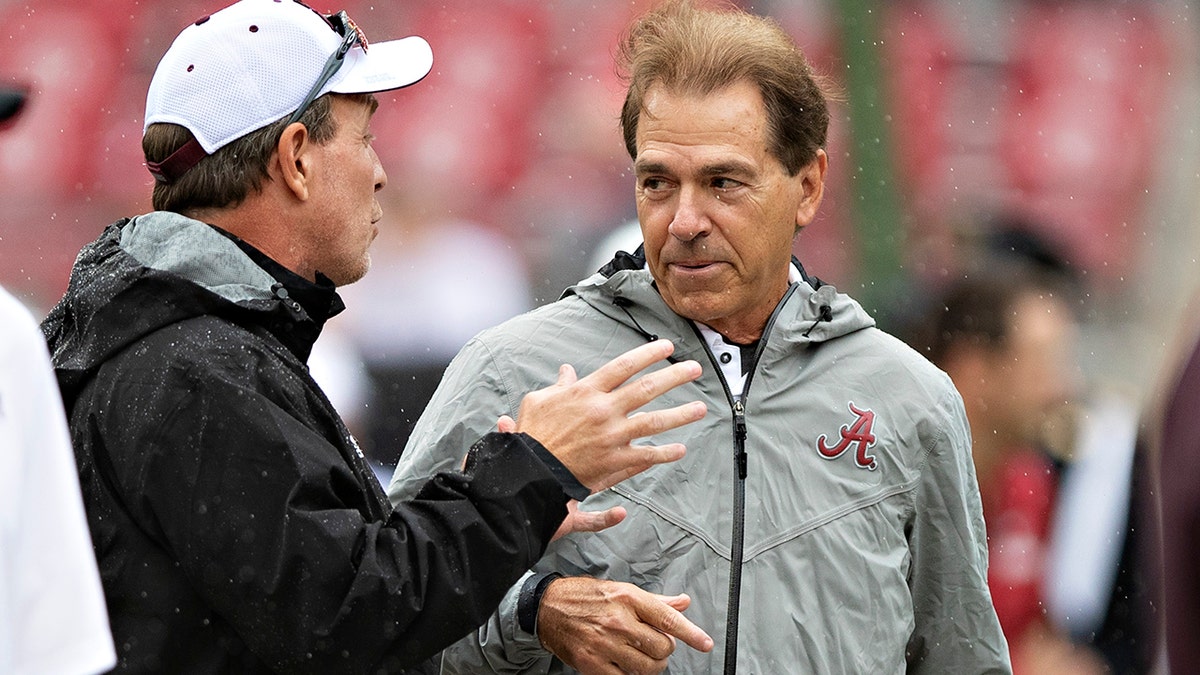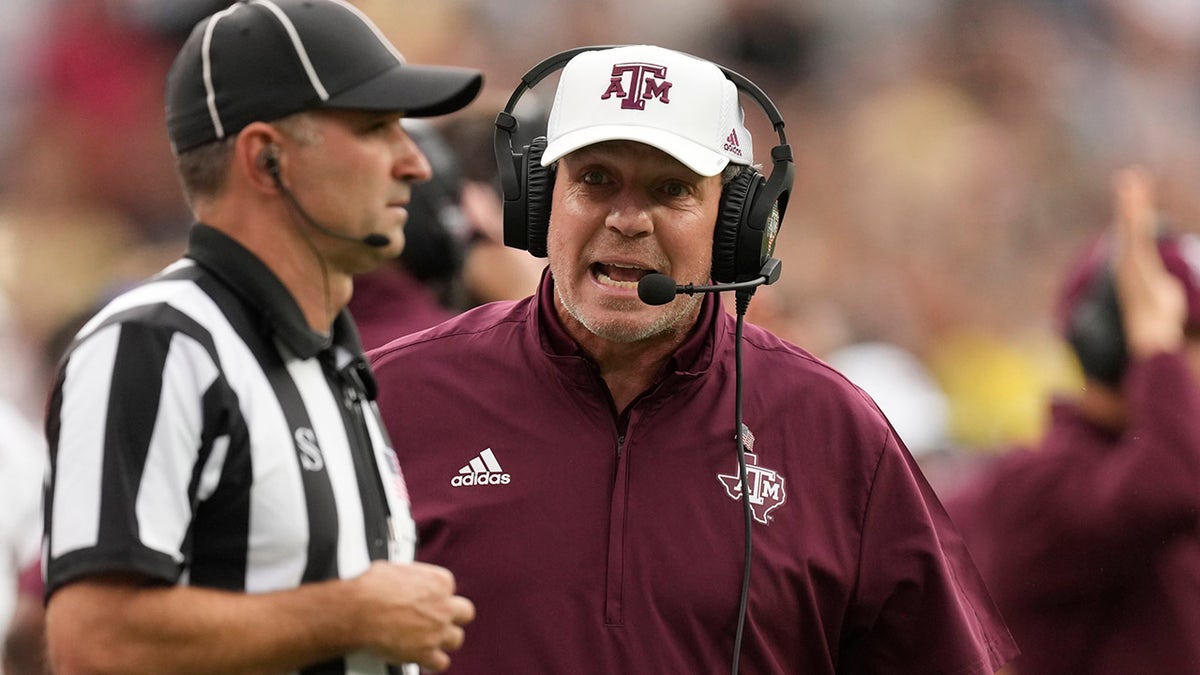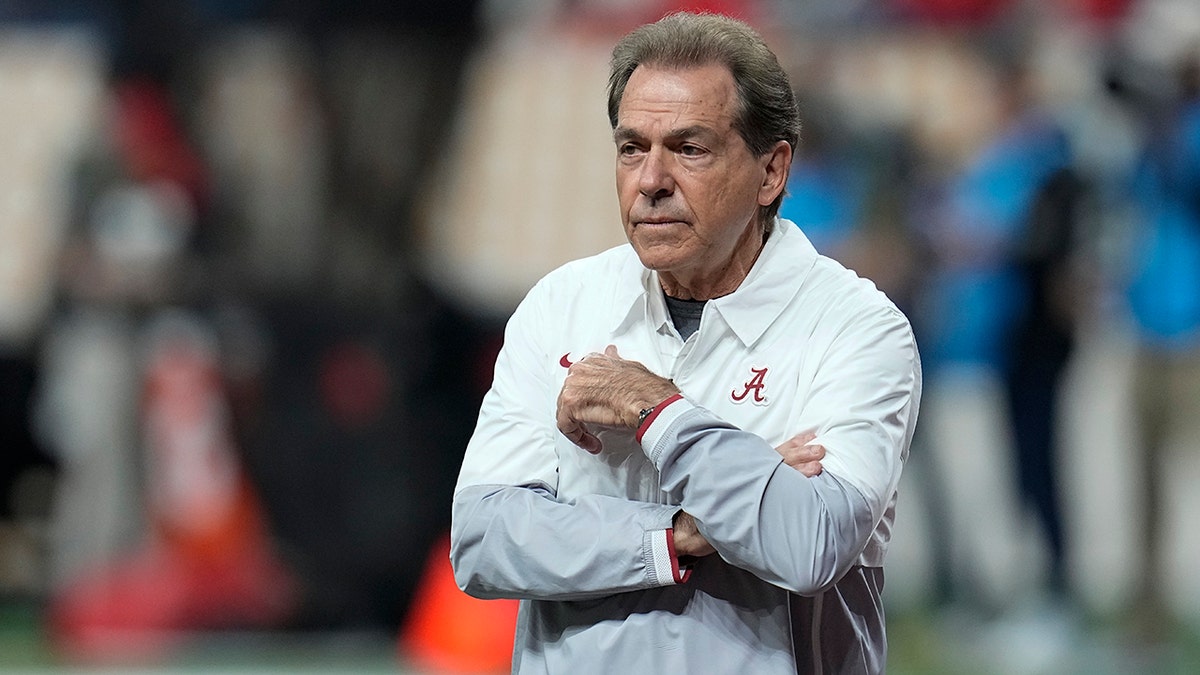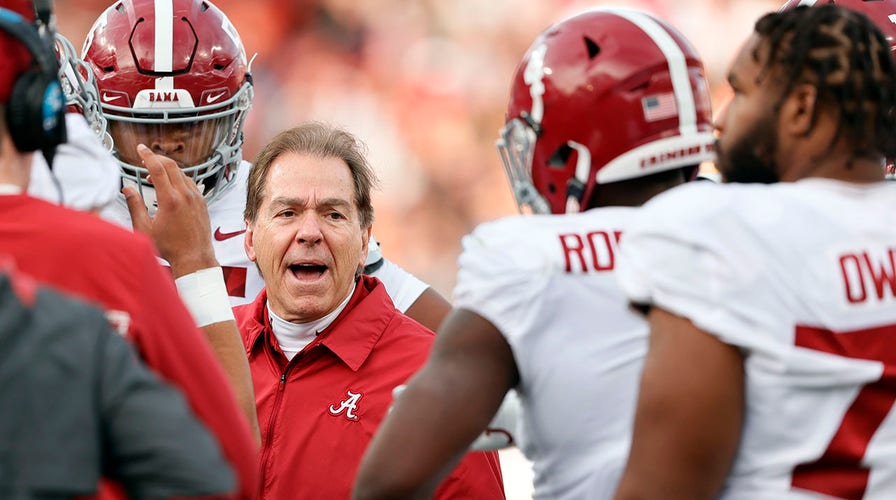Fox News Flash top headlines for May 19
Fox News Flash top headlines are here. Check out what's clicking on Foxnews.com.
As fans gleefully dissect the public attacks being levied by Alabama’s Nick Saban to Texas A&M’s Jimbo Fisher and vice versa, the larger context of their college athletics battle is being lost. Saban vs. Fisher, while wildly entertaining, isn’t just a personal feud, it’s symptomatic of the massive changes that have been wrought in college football in the space of only a couple of years.
Without most realizing it, college sports have moved from Communism to capitalism. This is the dynamic undergirding virtually everything you’re seeing happen in college sports right now. We’ve seen a fundamental paradigm shift in college athletic governance, moving from Communism to nearly unfettered capitalism. That has massive consequences for all the stakeholders in college sports — the players, the coaches, the fans, and the schools.
Now let me explain what I mean when I say we’ve moved from communism to capitalism: for its entire history, or at least since the NCAA’s founding, college sports have operated under the principles of communism. A relative handful of people — coaches, administrators, NCAA bureaucrats, and state university athletic departments — became very wealthy, while the vast majority of the valuable labor producing the value — the players — worked for well below market rates. The NCAA was, essentially, the Berlin Wall, keeping everyone in college athletics, at least to a large degree, behind the Iron Curtain, hidden from the free markets of capitalism.
CLICK HERE FOR MORE SPORTS COVERAGE ON FOXNEWS.COM

Head Coach Jimbo Fisher of the Texas A&M Aggies talks at midfield with Head Coach Nick Saban of the Alabama Crimson Tide at Bryant-Denny Stadium on September 22, 2018 in Tuscaloosa, Alabama. The Crimson Tide defeated the Aggies 45-23. (Wesley Hitt/Getty Images)
Then what happened?
The NCAA’s Berlin Wall collapsed.
Virtually overnight we’ve gone from a regulated communistic state behind the Berlin Wall to (mostly) unregulated capitalism when the wall came tumbling down. Whereas before the NCAA enforcement agents patrolled college athletics to ensure no one received "improper benefits," a totally made up communistic phrase if ever there was one (what the hell even is an "improper benefit?") now we have players effectively selling their labor on the open market. There was no middle ground here, we just flipped from one governance structure to another with virtually no middle ground or transition period.
Under the NCAA’s communistic system money could be spent on certain privileged individuals — coaches — and in certain ways — on facilities and dorms and eating halls — but the money was restricted from being spent on the most important assets — players. So under our old system college coaches could make $10 million a year — remember, some communists are always really rich — and college weight rooms had waterfalls, but players, the average citizen, was restricted in profiting off their labors. (Ironically some of the foremost proponents of capitalism, red state living Republican voting fans, are the most upset by college communism ending. To a large degree I suspect that’s because many are just uncomfortable with change and haven’t spent much time thinking about what they actually support. So if you’re one of these people, I’d just ask you this, why do you want to make as much money as possible in your life and not want that for other people? I’m an unabashed capitalist, I want everyone selling their labor for as much as they can. That’s my goal, isn’t it yours too?)
But, again, college football has been communism for a long time. Except in certain limited circumstances, like when it came to paying coaches, which was almost completely unregulated. This is why I’ve been arguing for years on this site that based on college football’s inefficient market environment Nick Saban deserved $100 million a year to coach. Because while you weren’t allowed to pay the players, if you paid Saban enough to leave Alabama, he’d be able to win at your school just like he won at Alabama. And the benefits Saban has brought to Alabama are worth many times in excess of his salary. Not just in titles, which are great, but in terms of the growth of Alabama’s stature as a university. The overall enrollment at Alabama has more than doubled since Saban arrived, SAT scores have skyrocketed, over half of all Tide students are from out of state. Think about it, Nick Saban is so successful at coaching football that rich parents in New York and California are clamoring to send their kids to school in Alabama! That’s something that had never happened in our nation’s history, and it’s almost all because of Nick Saban’s football acumen.
Under the existing communistic structure, Nick Saban had a (virtual) college football monopoly. Saban has had the number one ranked team at some point in the season in 2008, 2009, 2010, 2011, 2012, 2013, 2014, 2015, 2016, 2017, 2018, 2019, 2020, and 2021. That’s fourteen straight years, unheard of in all of college football history. How does that happen? Well, when every school can, at least in theory, offer the same scholarship, which provides essentially the same value everywhere, why wouldn’t top players go to the school where they could win a title and apprentice until they were able to sell their talents to the NFL and make real money? The only way to beat Alabama under the existing NCAA system was to get a better coach than Nick Saban — good luck — or recruit better players than Nick Saban — good luck again.
NICK SABAN, JIMBO FISHER TIT-FOR-TAT YIELDS SEC REPRIMAND

Alabama head coach Nick Saban talks with players in a time out during the first half of an NCAA college football game against Auburn Saturday, Nov. 27, 2021, in Auburn, Ala. (AP Photo/Butch Dill)
Nick Saban has built the college football equivalent of the Google search engine. No one else can compete with him. And if someone does start to compete with him? Well, Saban just does what they do better than them. I mean, Nick Saban is smart, you don’t achieve dominance as long as he has without being able to adjust. Look no further than Saban’s evolution from top critic of spread offenses to diehard advocate. Saban’s early title teams featured quarterbacks like Greg McElory and Jacob Coker running, comparatively, plodding offenses. If you watch tape of Alabama’s offenses from 2007 and compared it with 2019 and 2021, as Tua and Bryce Young force the ball down the field, it’s night and day. Saban is about to put three straight starting quarterbacks into the first round of the NFL, something that had never happened in his tenure before. That’s because he evolved with the sport.
But that was on field evolution.
What Nick Saban can’t control is the NCAA’s Berlin Wall falling down and challenging his (near) football monopoly in a larger structural arena, namely his ability to get top players.
That’s why it’s no surprise that Nick Saban’s Alabama, which has dominated college football for the past 15 years, is upset by massive change. Major paradigm shifts typically challenge those in power. If you’re dominant and in power the last thing you want is the Berlin Wall to come tumbling down. You want the existing infrastructure to stay in place. Blockbuster didn’t want streaming to happen because it created Netflix. And Saban didn’t want the NCAA’s Berlin wall to come down.
This past recruiting class put Saban on notice. Sure, it was Texas A&M this time, but the Aggies were just ahead of the game. Saban realizes its competitive advantage is being attacked. And unlike past challenges to Saban’s dominance — the spread offense — this isn’t just something that can be co-opted by Alabama. Why not? Because the spread offense didn’t challenge Alabama’s recruiting dominance, this does. Alabama, at least compared to the Texas, Texas A&M’s USC’s and, yes, the Tennessee’s of the world, doesn’t have that many billionaire boosters willing to spend big money for top players. While many are simply expecting Nick Saban to wave his magic wand and produce massive amounts of money to sign players, Alabama isn’t that wealthy compared to other big college football programs.
For once, Saban may not have a competitive advantage. Jimbo Fisher, sitting flush in the Texas oil fields, has more money to spend on players than Nick Saban does. And Nick Saban sees that and it makes him angry. His monopoly is challenged.
Look, the primary reason I believe Nick Saban left the NFL to return to college was because he saw the competitive disadvantages of college football and believed he could exploit them to his advantage. Unlike in the NFL where every team, usually, gets one first round pick a year, Saban realized he could sign five or six first rounders at Alabama every year. He knew he was as good of a head coach as Bill Belichick, but unlike Belichick, who had Tom Brady — a top quarterback is the cheat code for the NFL — he could exploit the inefficiencies of college football to his advantage, bend the college football world to his direction. Saban is a great coach, but, really, in essence, he’s just a businessman who is running the best business, one that creates monopolistic possibilities. Alabama football is Google.
(And sports, especially college football, was rife with inefficiencies Nick Saban could exploit. One reason, by the way, you are reading this article right now on Outkick is because over a decade ago I recognized my own market inefficiency and started this website. I realized that college football was being woefully undercovered nationwide, that there was a huge market for people who wanted to read about college football and have fun while doing it. Voila, Outkick. Now we have certainly expanded the purview of the site and there are many more people employed here today, but the lifeblood of the site, at least in my mind, will always be college football, the sport I love the most. Now Outkick isn’t Alabama football, no one is, but we’re comfortably in the top ten every year.)
What Saban fears in Texas A&M isn’t Jimbo Fisher and Texas A&M it’s that Jimbo has advantages that he doesn’t. The NCAA’s Berlin Wall tumbling down doesn’t favor Saban’s Alabama, which is the entrenched power, the rule change favors the super rich upstart with $100 barrels of oil gushing out every day making his boosters richer and richer.

FILE - In this Saturday, Sept. 11, 2021 file photo, Texas A&M head coach Jimbo Fisher argues with a referee in the second half of an NCAA college football game against Colorado in Denver. Texas A&M plays Arkansas on Saturday, Sept. 25, 2021. (AP Photo/David Zalubowski, File)
The result of this capitalism is a system that, left unregulated, will create what capitalism creates, a few big, colossal winners who soak up the top players, coaches, and titles. But this, interestingly, is likely to produce, at least in my opinion, more competition than the dominance Alabama has enjoyed over the past 15 years.
ALABAMA'S NICK SABAN REMAINS AGAINST CURRENT NIL SYSTEM, REGRETS SINGLING OUT SCHOOLS
Now is this good or bad for college football? Well, like many things, it depends on what kind of assets your favorite school has. And that’s also why it’s instructive to look to the NFL, the most successful sport in American history. The NFL doesn’t have unregulated capitalism. Because if they did whoever the richest owner is would win most titles because he’d be able to pay the most for the best players. (At least in theory). If the richest owner won every year that would hurt the sport. So what does the NFL do? It put in place a system to create near perfect parity, a system where any team, at least in theory, can win any game. (The limited amount of quarterback talent upsets NFL parity. But if there were, at least in theory, 32 totally equal quarterbacks then every team would pretty much finish .500 every year.)
So the NFL has a salary cap and a restricted number of franchises to ensure every team is a guaranteed success from a business perspective. (You’d have to be a total moron to lose money on an NFL franchise. In fact, it’s impossible. There’s never been NFL franchise contraction and no owner, at least to my knowledge, has sold a franchise for less than he paid for it in over two generations.)
But in order to have a salary cap you have to have a player’s union and the union has to collectively bargain with the owners to build out a CBA because otherwise you have what college football has right now which is an antitrust violation, which is what the Supreme Court created by essentially striking down the NCAA. Right now there’s no structure in place to allow a union to happen in college football. So you have unregulated capitalism when it comes to talent acquisition. That is, in theory any player can essentially sell his services to any bidder for whatever amount he wants to sell it for. And teams can now sign as many top players as they afford to sign. (I know the argument is players can only profit off name/image/likeness and can’t sell their services to teams, but in practical purpose this is a distinction without a difference. An artful lawyer can erase this issue completely. Make no mistake, players are 100% selling their services to the highest bidders.)
As if that weren’t enough, in addition to selling his services to the highest bidder, a player isn’t even bound by his NIL contract deal! (At least not so far.)
At the same time that players can sell their services, college football has also added a free transfer opportunity to all players. Which means an astute college player can now, wait for it, sell his collegiate services three times to the highest bidder. How so? A player can sell his services as a recruit, can then enter the transfer portal and sell them again, and then a player can graduate from a school and sell his services a third time. That is, in the space of four years, a college player could be an unrestricted free agent three times!
A first round NFL draft pick is bound to one team for five years under the NFL CBA, but a college kid can sell his services three different times in only four years. Which is why, wait for it, many college athletes are potentially going to make more money off college athletics than they will in pro sports.
Seriously, this is going to happen.
Probably quite a bit.
Instead of going pro, at least as long as this system exists, many kids are going to stay in college to maximize their earnings potential.
Okay, you might be thinking, is this unregulated capitalism good for college athletics?
Put simply, none of us know.

Texas A&M coach Jimbo Fisher reacts to an official's call during the second half of the team's NCAA college football game against Mississippi, Saturday, Nov. 13, 2021, in Oxford, Miss. (AP Photo/Rogelio V. Solis)
Because this can go many ways. Here’s one example of what unregulated capitalism could look like. What if a super rich billionaire decides he wants his team to win every national title? In theory, he could make that happen. I’ll give you an example, what if Elon Musk, instead of buying Twitter, decided he wanted his favorite college football team to win every title? Well, Musk, for probably a billion dollars, could found his own collective and guarantee a million dollars to every recruit for the rest of his life. Whatever school he wanted to support could then hand select the best high school athletes every year and build the greatest college football team of all time.
Sure, someone might occasionally beat this team — the school could be awful at projecting which players were going to be good and fail to develop their talent as well — but the competitive advantage that school would have, especially if it were combined with the best coaching staff money could buy, which it would be, would be virtually impossible to beat over time.
NICK SABAN-JIMBO FISHER RIFT LEAVES OLE MISS' LANE KIFFIN AMAZED: 'SHOULD HAVE BEEN ON PAY-PER-VIEW'
If a sport had the same champion fueled by a super rich billionaire every year, fans, likely, would stop to pay as much attention and the sport itself could wither. (After all, the lesson of the NFL is that fans want to believe their teams can win a title. And in order for that to happen you need some form of parity.)
That’s one possibility of what unregulated capitalism could look like.
Another possibility is that the top 25 or so schools, the ones with super rich boosters willing to spend a ton of money, will reach some form of competitive equilibrium, where the market value of recruits is eventually set, much like the price of a company is eventually set — after all, for every five star that turns into a stud, there’s at least one that turns into a gridiron bust — and those top schools duel in a more competitive environment than we have now.
Another possibility is that Title IX lawsuits will be filed challenging the ability of top college football and men’s basketball players to make so much money while other athletes, overwhelmingly women, get comparatively little. (No women’s athlete in college is likely to ever receive substantial payments to sign with a school because there are no women’s sports that produce substantial revenue.) Right now all schools have to treat all scholarship athletes the same, male or female, and under Title IX the number of scholarships have to be the same too. Well, NIL destroys that. Is it legal for (mostly) state educational institutions to pay men millions to compete for them and not pay women anything? I don’t know.
Anyone who tells you exactly how this is going to shake out is lying to you.

Alabama head coach Nick Saban watches warm ups before the College Football Playoff championship football game against Georgia Monday, Jan. 10, 2022, in Indianapolis. (AP Photo/Paul Sancya)
What would my magic wand solution be as someone who loves college athletics? A salary cap that all schools in the same conference agree to abide by. Why wouldn’t college football copy the NFL if it could? Right now the unfettered free market is going to lead to some recruits making millions of dollars a year while most of their teammates make a tiny pittance of that. Would it be better for top college football programs if, for instance, every player made $100k than for one player to make a million and another player to make $5k? I think so. Given that there are 85 scholarship football players, every player could make $100k, plus their existing scholarships, for $8.5 million. That feels reasonable to me.
But how many schools could pay for this?
And, leaving aside the fact that there would need to be a union to create this kind of CBA, would it even be legal to only be paying football players and men’s basketball players, which are the only two sports in colleges that make money? Remember, right now the money athletic departments make in football and men’s basketball gets redistributed for scholarships in other sports, track and swimming, for instance, which would never be able to afford to give scholarships based on the revenues they produce.
My point is, I don’t have all the answers, no one does.
But what I do know is the NCAA’s Berlin Wall is down and unfettered college capitalism is here for the moment. It’s a capitalistic wild west. And what you’re seeing now are the figurative shoot outs in the town square, Nick Saban and Jimbo Fisher are wearing white and black hats standing in front of each other at sundown in the SEC town square. One question is, who’s wearing the white hat and who’s wearing the black hat?
CLICK HERE TO GET THE FOX NEWS APP
But more alarmingly to both men, we don’t even know yet who has the biggest gun.
All we know is that the NCAA’s Berlin Wall is in tatters.
And that almost overnight everything in college athletics has changed.
Potentially forever.

